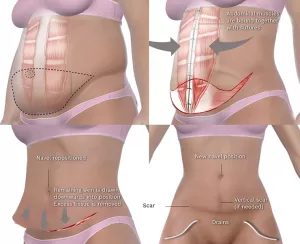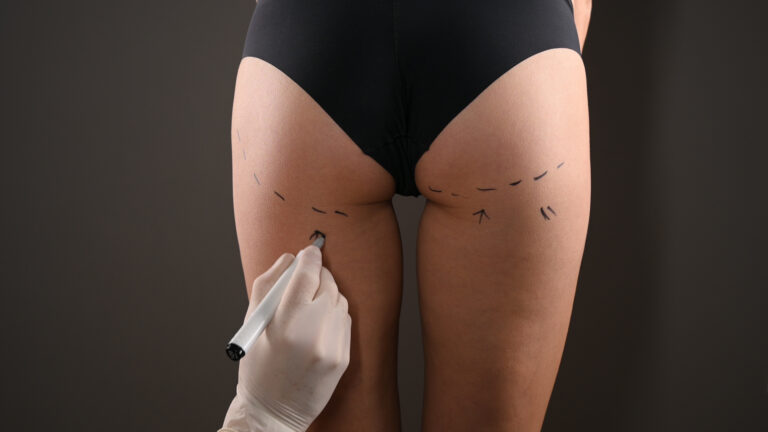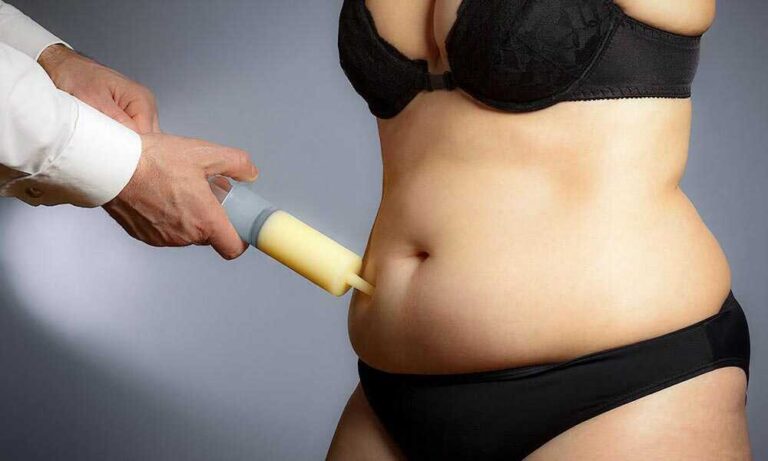Tummy Tuck / Abdominoplasty
A Tummy tuck, also known as, abdominoplasty is done with the following objectives in mind:
- Remove excess fat, skin and tissue
- Strengthen the weakened and separated muscles of the abdominal wall (Diastasis Recti)
- Contour the abdomen and make it look flat, smooth and contoured
The modern approach to tummy tuck is Lipo-abdominoplasty, wherein, we combine liposuction of specific areas along with the tummy tuck to enhance the contour and give better definition to the result.
The umbilicus is mostly preserved, repositioned for better cosmesis. In some cases, it is totally reconstructed, referred to as neo-umbilicoplasty.
Why Tummy Tuck Surgery Is Done?
- To correct a flabby abdomen which does not go down with exercise/diet.
- The abdominal shape has been affected by pregnancy, massive weight loss or ageing
- A protruding abdomen which is considered unattractive
- You can hold a pannus of tissue with both your hands above/below the belly button.
- You get recurrent fungal or other skin infections under the excess pannus.
- You are under confident of yourself due to your body form.
- You have an abdominal wall hernia along with weak abdominal wall muscles.
Procedure of Tummy Tuck Surgery
Abdominoplasty involves removal of excess fat, skin and soft tissue from the lower abdominal area. Most of the excess fat is liposuctioned. The lax abdominal wall musculature is tightened, hernia if any is reduced, and the fascial tissue reinforced to give higher definition to the musculature. The excess skin envelope is pulled down over the now taut abdominal musculature to measure the excess and tailored accordingly. The umbilicus is repositioned. The flaps are stitched aesthetically with absorbable sutures. Drains may or may not be kept.
The procedure has excellent long lasting, natural looking results. Therefore, they are very desirable, especially in people who would like to see immediate differences in their body.

Full Tummy Tuck
A full tummy involves removal of all possible excess fat, soft tissue and skin, rendering your tummy, near complete flat and toned. This procedure is highly desirable for women who have gained pregnancy weight (and could not lose it) and hence is pivotal in a Mommy Make Over. The incision although big, stays well-hidden below the undergarment line. The divaricated recti muscles are corrected, and the pubic area is tightened. This is also said to improve the appearance and functionality of the genitals (Mons pubis and vulvar area), referred to as “monsplasty”. A new belly button may be created depending on the laxity of the umbilical stalk and the amount of skin/soft tissue to be excised.
Mini Tummy Tuck
The main area of focus in this procedure is the lax area below the belly button. The incision is much smaller (approximately size of the LSCS scar). The amount of fat, soft tissue and skin removed is also much less. It may not address the divarication of recti in entirety, but involves tightening the infra-umbilical musculature.
Brazilian tummy tuck
This procedure, mimics the full tummy tuck with strategically added tightening of the fascial systems of the abdominal musculature to render an hour glass figure. However, the pre-requisite for this recently popularised tummy tuck variant, is that one should have a good abdominal muscle tone with a somewhat fit physique. In short, a good base is required to build up a master piece!
Recovery After Tummy Tuck Surgery
- Outpatient procedure mostly, day-care surgery
- You may have some swelling, bruising & discomfort for the first few days. It is only temporary and diminishes as recovery proceeds
- You can start your daily routine work from next day after the surgery and can go for a walk and perform most activities of daily living
- You may return to your desk job 3 days post-op
- Avoid sudden movements, lifting weights, etc., for approximately 3-4 weeks.
- For minimum 4 weeks after the surgery, a belt or compression garment is used
- Most swelling, bruising and discomfort disappear in about one month and you will feel “back to normal”.
- By 6-8 weeks, you can begin most of your physical activities
- You may resume your normal pre-surgery life, approximately 3 months after the surgery
Risk involved
Like every surgery, there are potential complications and risks involved. Common risks involved in tummy tuck include, anaesthesia risks, bleeding, hematoma, a chance of infection, less sensation, scarring, seroma, asymmetry and persistent pain.
However, these complications are avoidable if performed by a competent plastic surgeon.


